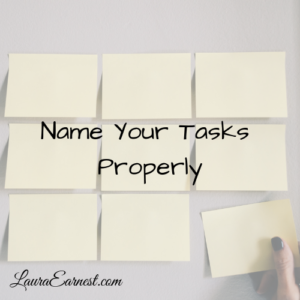Have you ever been going over your task list and come to a screeching halt? Did you stumble over the task because your brain didn’t know what to do with it? Properly naming tasks is one way to keep that from happening.
I am not very good at naming tasks. Even after years of doing Getting Things Done and absorbing productivity information, all which emphasize to keep tasks do-able. So here is how – and why – you need to properly name tasks.
Poorly Named Tasks = Avoidance
If you see a poorly named task on a list, your brain will either trip over it and then move on, or just skip it all together.
Let’s look at some examples from my recent lists.
- “Camper.” Was this winterize? Clean? Take out for a spin? Even winterize and clean have multiple different possibilities.
- “Salad.” Make? Eat? Throw out? Throw on the floor?
- “Watch show on science thing.” Sadly, I didn’t write down which show, or the topic, or the presenter, and I had no idea later.
- “Garden.” Is this a noun or a verb? Did I need to clean? Plant? Harvest? Fertilize?
- “Shopping list.” Do I make one? Order groceries?
- “Blog articles.” There is so much to be done on this one, that I can’t even start to list it all.
Properly Named Task = Good Time Estimate
If you have properly named a task, and added tasks for subsequent actions, you can understand how long it will take you to complete.
Looking at the list above, I cannot honestly give even a guess as to how long things would take.
The Structure of Proper Names
Putting together a properly named task isn’t hard. All you have to do is train yourself to do it.
The proper structure is [verb] [noun] [completion state]
Examples
Let’s take a look at my mess above.
- “Camper” was actually a series of tasks: “Winterize camper by removing all food.” (30 minutes) “Wash and store camper linens.” (30 minutes) “Buy antifreeze for camper water lines” (60 minutes) “Put antifreeze in camper water lines.” (30 minutes)
- “Salad” was about making a big salad that I could take all week for lunch: “Make 5 salads for work lunches” (20 minutes)
- “Watch show on science thing.” Lesson learned – be more specific when writing down a task.
- “Garden” was actually “Clean and store tomato cages” (15 minutes)
- “Shopping List” was “Make shopping list” (10 minutes) followed by “Order groceries” (15 minutes)
- “Blog articles” was too broad. It needed to be “Write article for [date]” (45 minutes) three times.
Conclusion
By properly naming tasks, you can keep your mind from stumbling over them, and get a clear picture of how long a task will take.
Action Item
Look at all your tasks on your task list. Are they named properly? Do you know exactly what needs to be done and have a feel for how long it will take?
Photo by Kelly Sikkema on Unsplash




